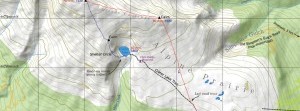
Photo Credit: Illustration by Facundo Gastiazoro
Warmth under snow— Why rising temperatures could mean harsher climate for some species
Broad, deep tracks in the fresh snow followed the logging road ahead of us. “First snow of winter,” my grandfather would say, “and the grizzly bears head for their dens in the mountains.” This was the first snow in November and, from the size of the tracks, a large grizzly had headed up the slope to higher elevations. As the snow deepened, we turned around, but the bear continued climbing.
At the time, it struck me as a bit odd, as black bears happily hibernate in valley bottoms. Why would grizzly bears in the inland north-coast seek out mid-slope to subalpine dens for the winter? It wasn’t until one wet, snowless January that the answer occurred to me: in the coastal valleys, snow cover varies from year to year, and may not occur or might melt out mid-winter. Higher elevation dens in the mountains ensure that grizzlies are sheltered and insulated under a cover of snow until spring. With spring comes sufficient food for both adults and cubs, but an early winter wake-up can lead to starvation.
So what would happen if our winter snow cover disappeared? Lack of snow cover directly affects the ecology of many subnivium ecosystems, exposing organisms to temperatures for which they are not adapted. Lack of snow also directly affects our homes and communities. Penetrating frost into soil not protected by snow can lead to frozen water and sewer lines. Heating costs in homes increase as cold extends around foundations susceptible to frost cracking and damage.
We northerners have a love-hate relationship with snow on the ground. Although lack of snow delights anyone with a long driveway, most of us groan and shovel, knowing that snow cover is essential for the survival of northern wildlife species. Where snow cover is a predictable occurrence—in the northern interior or above low elevations—both plants and animals have adapted to its insulating qualities during the coldest months of the year. At an air temperature of -40 C, the temperature of the soil surface beneath 1.5 metres of snow will hover near freezing. For invertebrates, fungi, soil bacteria and plant roots, snow maintains a mild winter temperature in which they can survive, compared to the killing cold up above.
A persistent snow cover or subnivium environment provides safety for animal species that are active in winter. Sausage-shaped red-backed voles build nests and elaborate grass tunnel systems along the interface between your lawn and the snow. Lack of snow exposes these voles to bitterly frigid temperatures, reducing rodent populations to such low levels that winter-adapted predators—owls, weasels, martens and foxes—can be affected.
Some birds, such as grouse and ptarmigan, burrow into powder snow at night to stay warm. Using the same principle of a warm blanket of snow, northern mammals will curl up in drifting snow or huddle down in snow-covered dens, emerging through snow tunnels to the surface. Cold-blooded amphibians beat a hasty retreat in late fall, burying themselves into wet seepages or pond bottoms insulated by deep overlying layers of snow and ice.
Some of our northern winter species are especially designed to work within a snow cover. Moose have long legs to wade through moderate snow levels, feeding on shrubs protruding above snow level. Mountain goats and mule deer avoid areas of deeper snow but will dig through shallow snow to reach winter food. Snowshoe hares and their predators, lynx, have enlarged hairy feet, which allow them to run on top of the snow. Fast hares are pursued by faster lynx, especially if the snow becomes crusty.
By filling in the underworld of bogs, swamps, dips and hollows, snow also allows people to move quickly and efficiently through the winter landscape. First Nations in northern BC built snowshoes to travel like wolves across the snow’s surface. Snowshoes were essential for winter hunting. Without them, a person could sink waist-deep or disappear into snow-covered gullies. By adjusting the length and width of the snowshoe design, travel was possible throughout the winter season. In regions with deep, powdery snow, snowshoes were long and narrow, compared to the bear-paw-shaped snowshoes for areas with denser, heavier snow.
Most Europeans who moved into northern BC in the 1800s and early 1900s adopted the use of snowshoes and dogsleds to move about the winter landscape. Trails were trampled in with snowshoes and the rough, bushy terrain disappeared under a firm, snowy highway. In the Stewart area, even horses wore snowshoes as they carried supplies to the mines and ore back to the docks for shipping.
In the early days of farming in the North, the insulating qualities of snow were used to extend both the types of plants that could be grown and how long produce could be saved through the winter. Farmers banked snow over precious rose beds and berry bushes to protect them from deep frosts, or buried fresh vegetables under a thick layer of hay covered with snow to save fresh food for late winter consumption. Without a consistent and predictable snow cover, many homesteads’ perennial food plants would have been frozen by deep January cold snaps.
Today, snow cover is a multimillion-dollar industry, if one looks at the recreation investment in snowmobiles, tracked all-terrain vehicles, ski hills and cross-country skiing. Lack of snow cover causes a direct hit in tickets and equipment sales to the thousands of northerners and tourists who take advantage of our snowy winters.
Could we lose our snow cover? According to researchers at the University of Wisconsin-Madison, global warming is causing millions of square kilometers of North American snow cover to disappear. By comparing March snow cover in 1966 to 2012, large areas of land south of the 49th parallel were identified as having lost their late winter snow. Serious ecological impacts are occurring that may lead to downward shifts in the number of species living in these regions.
Although northern BC is well north of this zone, and snow cover loss has not yet become a persistent pattern, projections of increasing global temperatures raise questions as to how the winter ecology of our region will be affected. According to these researchers, as the stability of snowpack habitats becomes less predictable, management goals and regulations will become essential to protect snow cover from compaction and destruction of shallower snow areas by our recreation and industrial activities.
Reductions to the depth and duration of snow cover could be a future crisis for northern BC. Last winter, snowshoeing through the hills near my house after a fresh snowfall, the patterns of tracks, emerging and disappearing into the snow, were a testament to the biodiversity associated with our snowy winters. If this snow no longer comes, or leaves too early, who knows what will happen to the wild species that we all enjoy.




